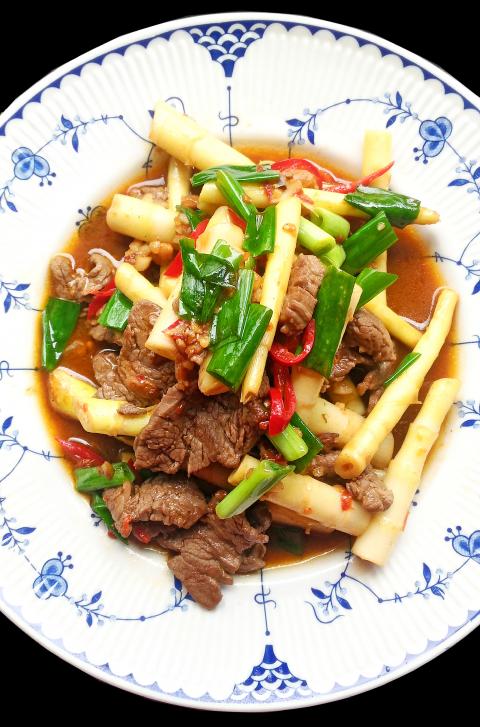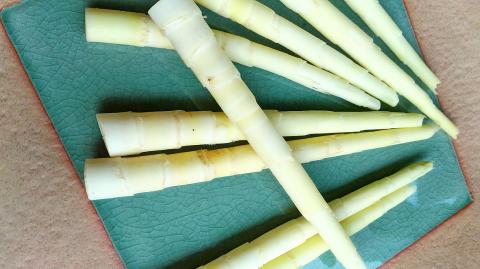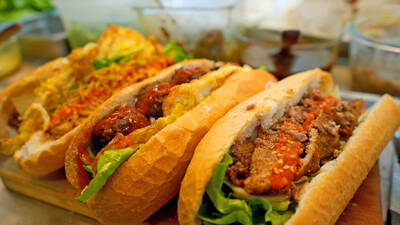Bamboo shoots come in many shapes and sizes, available during different seasons of the year. They are hugely popular in Asian cuisine, particularly in Southeast Asia, and also feature in various Indian regional cuisines. While bamboo has become a familiar part of the gardening landscape for people outside Asia, the eating of bamboo shoots remains almost entirely absent from the culinary traditions of Europe and America.
Taiwan is notable for its affection for bamboo shoots of various types served in a wide number of guises. If you have ever had a traditional Chinese breakfast of congee, you may well have had preserved bamboo shoots which are a frequent side dish, and they appear on the dinner table in everything from cold collations to soups and stir-fries. Among the bewildering variety of bamboo shoots cultivated in Taiwan, arrow bamboo is one of the most prized due to its relatively small area of cultivation and short season. The arrow bamboo season heralds the spring, and is awaited with the same eagerness as the first asparagus (though it does have a second bloom in autumn, but the shoots at that time are regarded as inferior).
Arrow bamboo shoots have many similar qualities to the temperamental asparagus. Selecting shoots of the highest quality is especially important, as inferior quality shoots can be bitter and fibrous. It is important to carefully cut away every last vestige of fibrous husk, as picking the stiff fibers from between your teeth can seriously compromise the eating experience.

Photo: Ian Bartholomew
Arrow bamboo is valued for its crisp texture and mild flavor, and its two most common manifestations are in a light refreshing soup, usually with pork ribs or chicken, which highlights their flavor, or as a stir-fry, with shredded pork, where their texture comes to the fore.
Living in Hualien, we are particularly fortunate in regard to the arrow bamboo season, as one of the biggest areas of production is in the township of Guangfu. Driving through the township in March and April, the No. 9 Highway is dotted with stalls selling arrow bamboo. Outside each stall is usually a huge pile of husks, as the vendor engages in the labor-intensive process of husking the shoots for sale (though additional cleaning might be required in the kitchen).
FORAGED FOOD

Photo: Ian Bartholomew
Arrow bamboo shoots are particularly associated with the cuisine of Taiwan’s Aborigines, and were one of the earliest “foraged” foods to gain widespread traction in mainstream culinary culture. They have since been followed by such vegetables as bird’s nest fern and fiddle neck fern.
Indeed, arrow bamboo has become such a commonplace in Taiwan’s culinary landscape that it is often forgotten that unlike the winter shoots of the tortoise shell bamboo (冬筍) or the shoots of the Oldham’s bamboo (綠竹筍) that make their appearance in late spring, the arrow bamboo is uniquely associated with Taiwan’s indigenous cuisine and does not owe any debt to the culinary traditions of China.
Arrow bamboo was originally a foraged food, laboriously harvested from the forest floor and eaten only by Aborigines or dedicated foodies in search of new experiences. Increased production, particularly in Hualien County, has meant that these shoots have lost something of their foraged cache, but they are still thought of as “natural,” if not entirely organic, due to the relatively small-scale production. As the shoots are harvested only a few days after they appear above ground, there is little need for pesticides to keep away bugs.
Away from areas where the shoots are available fresh, they are sometimes sold preserved in liquid, but this convenience is not one that I have yet had to resort to. Internet comments suggest that these “preserved” shoots can be of very mixed quality and at best need to be carefully washed off before use.
Look for shoots that are firm but not stiff. They should be a creamy yellow in color and shoots with too many hints of green should be avoided. Even the best shoots may have hints of bitterness, and it is always best to blanch them in boiling water before using, regardless of what you are preparing.
Arrow bamboo shoots are rich in vitamins and nutrients and according to some food commentators they are easier to digest than other varieties of bamboo. They are also very low in calories, and generally have a good profile for weight-conscious types. For all their excellent qualities, it should be noted that arrow bamboo shoots, as with all other bamboo shoots, must not be eaten raw, as they contain cyanogenic glycosides, a chemical associated with the poison cyanide. This is the same element that can be found in plants like cassava, and must be broken down by cooking or preserving before it becomes safe to eat.
Spicy arrow bamboo shoots with beef
Recipe
(Serves 4)
Ingredients
150g beef tenderloin (or other cut such as strip loin or blade)
150g arrow bamboo, husked
1 tbsp rice wine vinegar, or white vinegar
1 tsp soy
1/4 tsp white pepper
4 cloves garlic, minced
1 large chili, finely sliced
4 stems scallions, roughly chopped
2 tbsp spicy bean paste (辣豆瓣醬)
1 tbsp rice wine
1 tsp sugar
80ml vegetable stock
2 tbsp vegetable oil
Directions
1. Check the arrow bamboo, cutting away any fibrous outer husk that may have been missed by the vendor.
2. Bring a pot of water to a boil. Add salt, vinegar and bamboo shoots. Bring back to a boil and cook for 3 minutes. Drain and set aside.
3. Slice the beef into thin slices and marinate in soy and white pepper for about 10 minutes.
4. Heat a wok or deep skillet and add the oil. When hot but not smoking, add the beef and sear quickly on one side over high heat. Stir once or twice, until the meat is about half cooked. Set the meat aside.
5. Using the same wok or skillet, fry the garlic until fragrant over medium heat, then add the chili and half the scallions.
6. Add in the spicy bean paste and thin it with stock, cooking it over medium heat for about a minute. Add sugar and give it a good stir.
7. Turn up the heat, then toss in the bamboo shoots and the beef, and stir vigorously to coat the shoots with the spicy sauce. Just before it’s all ready, add the rice wine and the remaining scallions.
8. Serve hot with white rice.
Ian Bartholomew runs Ian’s Table, a small guesthouse in Hualien. He has lived in Taiwan for many years writing about the food scene and has decided that until you look at farming, you know nothing about the food you eat. He can be contacted at Hualien202@gmail.com.

Following the rollercoaster ride of 2025, next year is already shaping up to be dramatic. The ongoing constitutional crises and the nine-in-one local elections are already dominating the landscape. The constitutional crises are the ones to lose sleep over. Though much business is still being conducted, crucial items such as next year’s budget, civil servant pensions and the proposed eight-year NT$1.25 trillion (approx US$40 billion) special defense budget are still being contested. There are, however, two glimmers of hope. One is that the legally contested move by five of the eight grand justices on the Constitutional Court’s ad hoc move

Stepping off the busy through-road at Yongan Market Station, lights flashing, horns honking, I turn down a small side street and into the warm embrace of my favorite hole-in-the-wall gem, the Hoi An Banh Mi shop (越南會安麵包), red flags and yellow lanterns waving outside. “Little sister, we were wondering where you’ve been, we haven’t seen you in ages!” the owners call out with a smile. It’s been seven days. The restaurant is run by Huang Jin-chuan (黃錦泉), who is married to a local, and her little sister Eva, who helps out on weekends, having also moved to New Taipei

The Directorate-General of Budget, Accounting and Statistics (DGBAS) told legislators last week that because the Chinese Nationalist Party (KMT) and Taiwan People’s Party (TPP) are continuing to block next year’s budget from passing, the nation could lose 1.5 percent of its GDP growth next year. According to the DGBAS report, officials presented to the legislature, the 2026 budget proposal includes NT$299.2 billion in funding for new projects and funding increases for various government functions. This funding only becomes available when the legislature approves it. The DGBAS estimates that every NT$10 billion in government money not spent shaves 0.05 percent off

Dec. 29 to Jan. 4 Like the Taoist Baode Temple (保德宮) featured in last week’s column, there’s little at first glance to suggest that Taipei’s Independence Presbyterian Church in Xinbeitou (自立長老會新北投教會) has Indigenous roots. One hint is a small sign on the facade reading “Ketagalan Presbyterian Mission Association” — Ketagalan being an collective term for the Pingpu (plains Indigenous) groups who once inhabited much of northern Taiwan. Inside, a display on the back wall introduces the congregation’s founder Pan Shui-tu (潘水土), a member of the Pingpu settlement of Kipatauw, and provides information about the Ketagalan and their early involvement with Christianity. Most